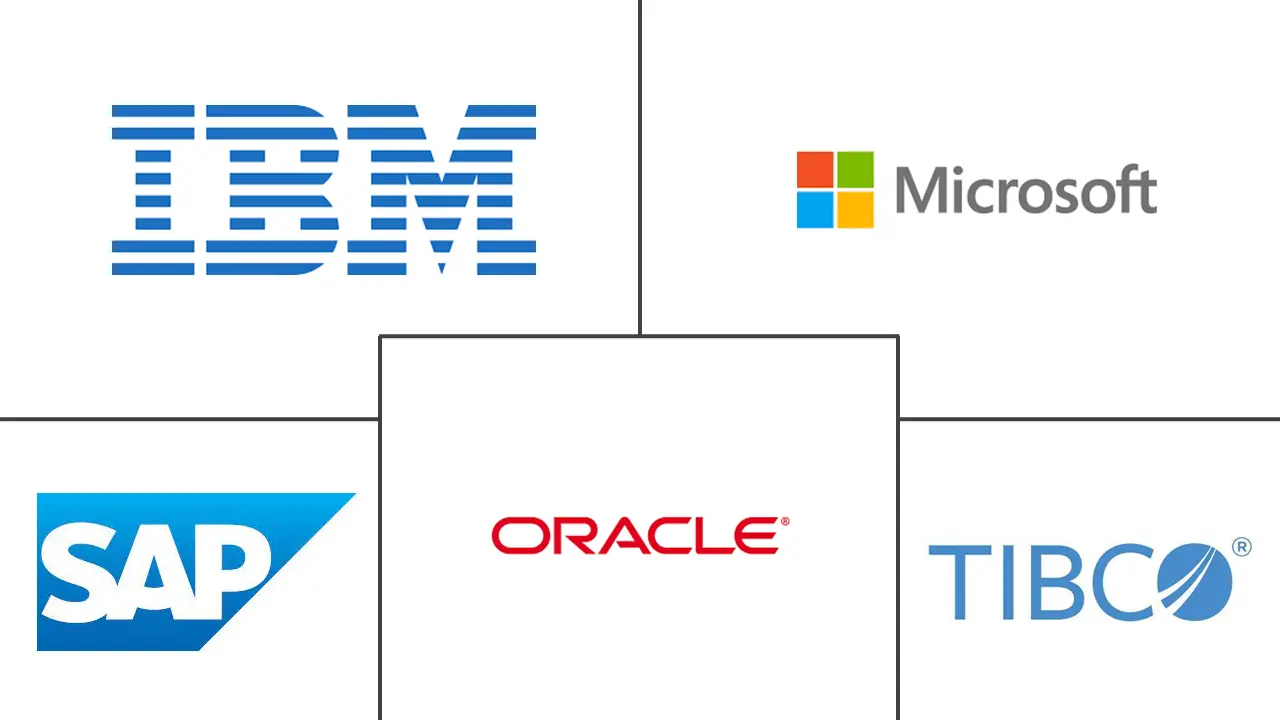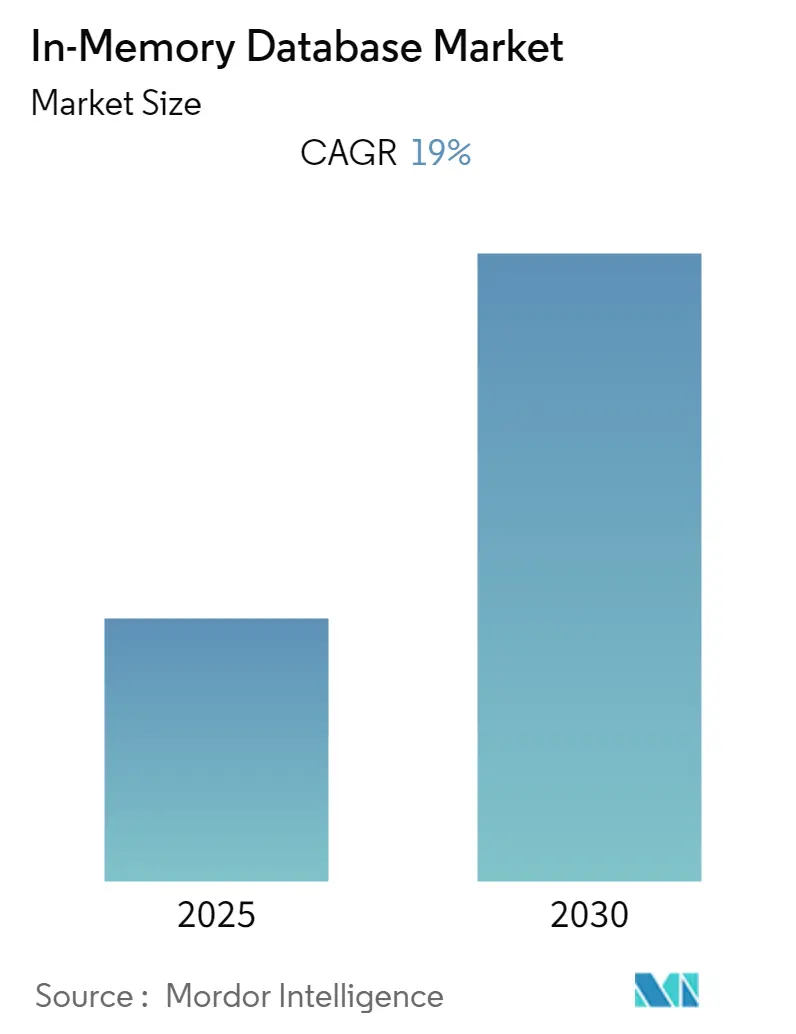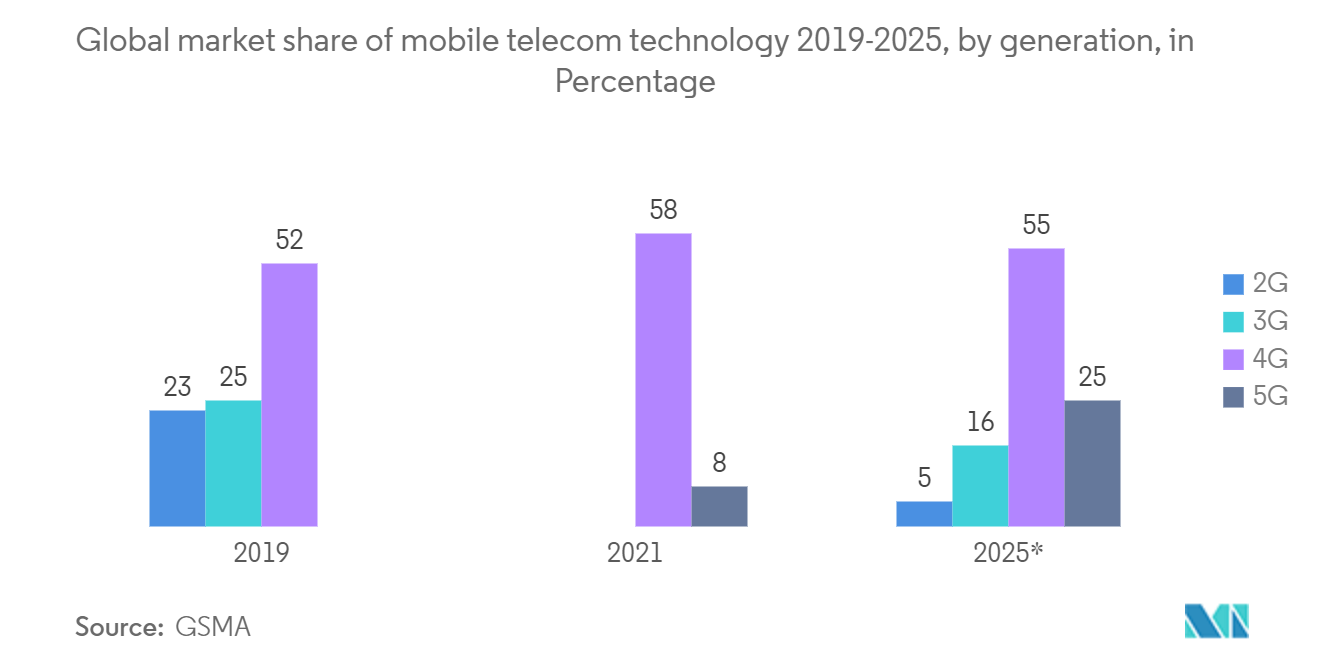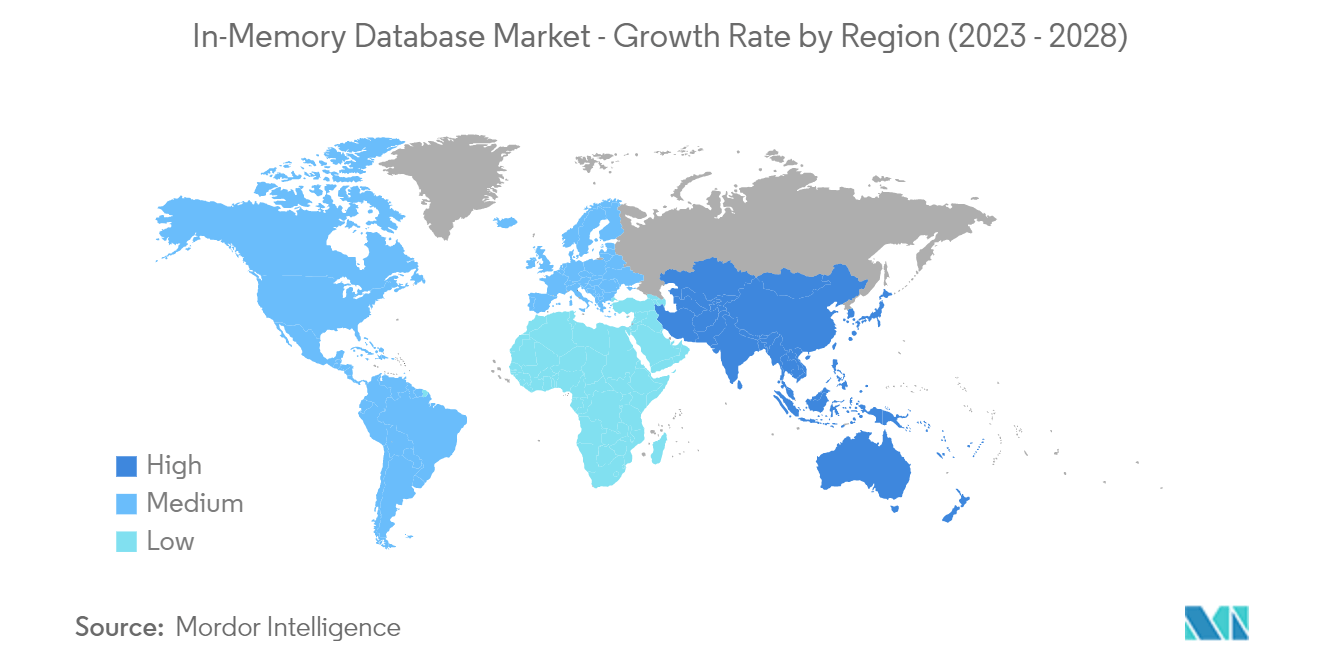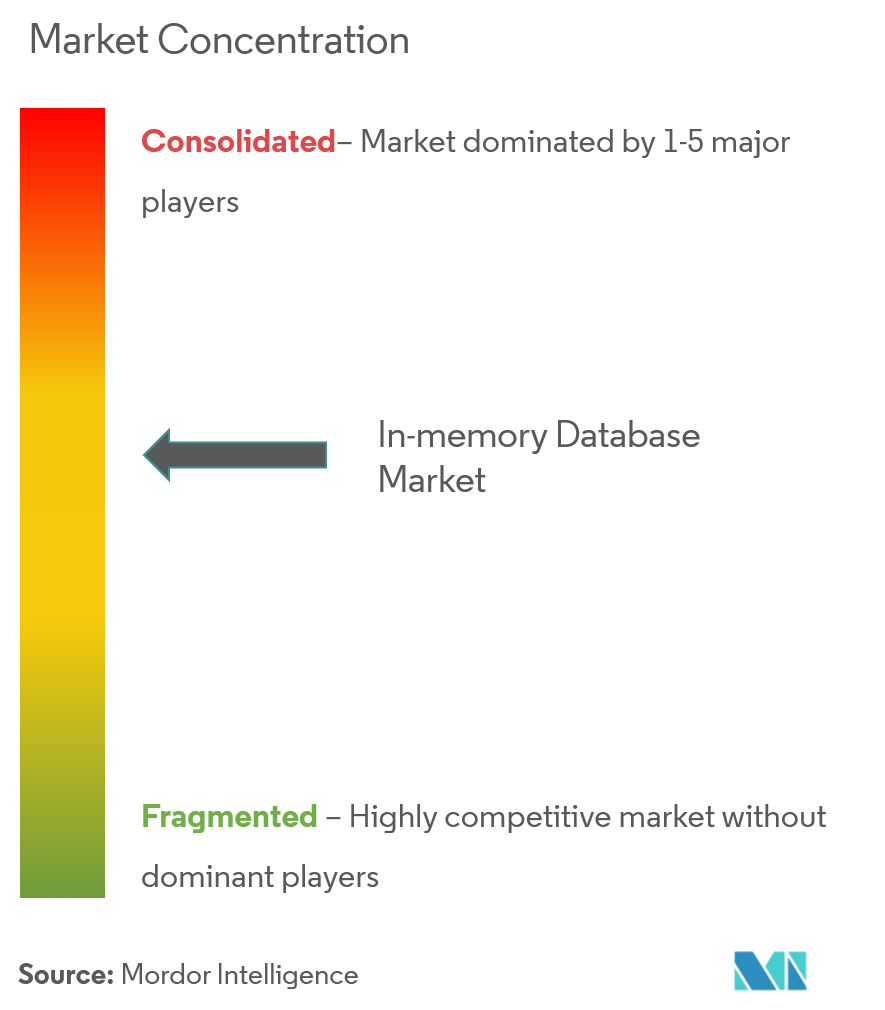In Memory Database Market Analysis
The In-Memory Database Market is expected to register a CAGR of 19% during the forecast period.
- In-memory computing is gaining popularity worldwide as a novel means of boosting performance and processing. The market for in-memory computing is being driven by the growing use of in-memory databases and computing in corporate firms, the growing use of in-memory computing by airlines to meet SLAs, and the spread of big data to automate and improve decision-making.
- It also grows as machine learning and artificial intelligence transform the technology industry by making data processing easier and faster for corporations, banks, and other services. According to IBM, in the last year, North American AI adoption rates will have reached 25% for implemented AI and 43% for researching AI.
- The in-memory database market is being driven by many things, such as the ability to solve problems with data analytics in real time and speed up digital transformation for businesses.The data generated by these devices can provide unique data pertaining to individuals that can be leveraged to gain insights, which prove to be game changers for industries. Smartphones and various trends, like the Internet of Things, contribute to increasing data production.
- Along with other trends like AI and machine learning, these IoT devices are being used in more and more industries. Using this data in real time in in-memory databases is a crucial part of this.
- The COVID-19 outbreak significantly influenced the expansion of the in-memory database market, as the growing number of mobile phone users, expanding use of smart devices, and booming e-commerce sector gave the market attractive potential for growth. COVID-19 created issues across the social, economic, and energy sectors, as well as in medical care. This crisis has several direct and indirect consequences for all aspects of society. Meanwhile, the digital and artificial intelligence industries can provide professional help in managing and controlling the viral spread. Due to the COVID-19 pandemic, increased health awareness among people led to many physicians and health workers delivering their services via apps. This factor is expected to boost the market's growth.
In Memory Database Market Trends
Telecommunication End-User Industry to Hold Significant Market Share
In-memory database technology is an essential option for any application requiring data to be promptly and reliably available. Examples of applications especially well-suited to in-memory database systems include networking and telecommunications applications with huge trading volumes and demands for exceptionally quick response times. In reality, the communications industry has been utilizing specialized in-memory technology for some time.
- The telecommunications industry has been going through some massive operational transformations. The data generated has been increasing exponentially. One of the primary reasons for this could be the advancement of telecom technologies and the development of disruptive over-the-top offerings by technology companies.
- In-memory databases are increasingly being used in telecom and IT enterprises to protect against attacks, minimize data loss, and strengthen security systems in big, complex, and varied organizations. The need for in-memory databases is anticipated to rise due to the increased number of data breaches in the telecommunications sector. For instance, in September last year, the Australian telecommunications firm Optus had a disastrous data breach that allowed access to the personal information of 11 million subscribers.
- Big data and growing mobile broadband usage have also increased the demand for in-memory databases in the telecom industry. In 2021, 4G technology held a 58% market share. However, by 2025, that percentage is expected to fall to 55%, according to the GSMA. By then, mobile technology is expected to be 25% dominated by the new 5G technology.
- Operators of mobile networks are not the only distribution network participants to use in-memory databases; original equipment manufacturers and infrastructure suppliers are also among them. The market is expected to grow a lot because more and more people are using technologies, especially cloud and mobility.
In-memory database systems are highly capable of doing enterprise management on the cloud, as they merge the data warehouse with clients' business applications, thus increasing data throughput. It also provides real-time analytics, which can assist organizations in foreseeing many issues and solving them beforehand.
North America Region to Hold Significant Share
- The North American region has been at the helm of many technological developments, and computing has been one of the key drivers. In the market studied, the majority of the landscape is dominated by North American players. The legacy of technological development and innovation has been a significant driver. Companies like IBM Corporation, Oracle Corporation, SAP SE, Altibase Corporation, Aerospike Company, and Microsoft Corporation are all based in the region.
- The Canadian market is anticipated to take center stage in the region as the country includes a considerable number of enterprises in various industrial sectors, such as retail, IT, or any other industry. Even US industries have substantial revenue from their operations in Canada.
- Although in-memory technology is still being developed, its adoption in enterprises has only recently begun.Since its adoption has begun fairly recently, the North American region has been lucrative for market vendors, and all the major players are looking to flood the market with low prices and high-performing offerings.
- The increasing awareness of the many advantages BI software provides gives businesses a wide range of options for focusing on their target audiences and improving the user experience. For instance, American food companies Wendy's and Ruby Tuesday heavily rely on BI software to improve customer interactions. As a result, these elements fuel market expansion.
In addition, the fundamental element that contributes to the growth of in-memory databases in North America is the rise in the utilization of mobile devices. The US Census Bureau and the Consumer Technology Association say that smartphone sales in the US went from USD 73 billion in 2021 to USD 74.7 billion in the last year.
In Memory Database Industry Overview
The in-memory database market is moderately consolidated. Some of the market players operating in the industry include IBM Corporation, Microsoft Corporation, Oracle Corporation, SAP SE, and TIBCO Software Inc., among others. The wide adoption of these IoT devices across industries and other trends, like AI and machine learning, is witnessing increased penetration.
Last year, IBM and SingleStore announced SingleStoreDB for December 2022. With the introduction of SingleStoreDB as a solution with IBM, companies are now moving forward in their strategic relationship to provide the quickest, most scalable data platform to power data-intensive programs. IBM has released SingleStoreDB as a service on Azure, AWS, and the Microsoft Azure Marketplace.
In April 2022, for the Integrity RTOS from Green Hills Software, McObject released the eXtremeDB/rt database management system (DBMS). The first and sole commercial off-the-shelf (COTS) real-time DBMS that satisfies the basic criteria of temporal and deterministic consistency of data is called eXtremeDB/rt. EXtremeDB was initially conceptualized, built, and implemented as an in-memory integrated database system for embedded systems.
In Memory Database Market Leaders
-
IBM Corporation
-
Microsoft Corporation
-
Oracle Corporation
-
SAP SE
-
TIBCO Software Inc.
- *Disclaimer: Major Players sorted in no particular order
In Memory Database Market News
- May 2022: IBM and SAP announced the extension of their collaboration as IBM embarks on a corporate transformation initiative to optimize its business operations using RISE and SAP S/4HANA Cloud. To execute work for over 1,000 legal entities in more than 120 countries and multiple IBM companies supporting hardware, software, consulting, and finance, IBM said it is transferring to SAP S/4HANA, SAP's most recent ERP system, as part of the extended relationship. The replacement for SAP R/3 and SAP ERP, SAP S/4HANA, is SAP's ERP system for large businesses. It is intended to work optimally with SAP's in-memory database, SAP HANA.
- November 2022: Redis, a provider of real-time in-memory databases, and Amazon Web Services have announced a multi-year strategic alliance. Redis is a networked, open-source NoSQL system that stores data on disk for durability before moving it to DRAM as necessary. It can function as a streaming engine, message broker, database, or cache. The business claims that when Redis is used as a database, apps may instantly search across tens of millions of rows of customer data to locate information specific to one particular customer. A managed database-as-a-service product on AWS is called the real-time Redis Enterprise Cloud.
- December 2022: The National Stock Exchange, the largest stock exchange in India, chose the Raima Database Manager (RDM) Workgroup 12.0 in-memory system as a foundational component for the next iterations of its trading platform front-end, the National Exchange for Automated Trading (NEAT).
In Memory Database Industry Segmentation
In-memory databases are purpose-built systems that store data largely in memory, as opposed to databases that store information on disks or SSDs. In-memory data storage is intended to provide fast reaction times by removing the requirement for disk access.
The in-memory database market is segmented by industry size (small, medium, and large), end user (BFSI, retail, logistics, and transportation, entertainment and media, healthcare, IT and telecommunication, and others), and geography (North America (US, Canada), Europe (Germany, UK, France, and Rest of Europe), Asia Pacific (India, China, Japan, and Rest of Asia-Pacific), and Rest of the World.
The market sizes and forecasts are provided in terms of value (USD million) for all the above segments.
| By Industry Type | Small and Medium | ||
| Large | |||
| By End-user Industry | Telecommunication and IT | ||
| BFSI | |||
| Logistics and Transportation | |||
| Retail | |||
| Entertainment and media | |||
| Healthcare | |||
| Other End-user Industries | |||
| Geography | North America | United States | |
| Canada | |||
| Europe | United Kingdom | ||
| Germany | |||
| France | |||
| Rest of Europe | |||
| Asia-Pacific | China | ||
| Japan | |||
| India | |||
| Rest of Asia-Pacific | |||
| Rest of the World | |||
In Memory Database Market Research FAQs
What is the current In-Memory Database Market size?
The In-Memory Database Market is projected to register a CAGR of 19% during the forecast period (2025-2030)
Who are the key players in In-Memory Database Market?
IBM Corporation, Microsoft Corporation, Oracle Corporation, SAP SE and TIBCO Software Inc. are the major companies operating in the In-Memory Database Market.
Which is the fastest growing region in In-Memory Database Market?
Asia-Pacific is estimated to grow at the highest CAGR over the forecast period (2025-2030).
Which region has the biggest share in In-Memory Database Market?
In 2025, the North America accounts for the largest market share in In-Memory Database Market.
What years does this In-Memory Database Market cover?
The report covers the In-Memory Database Market historical market size for years: 2019, 2020, 2021, 2022, 2023 and 2024. The report also forecasts the In-Memory Database Market size for years: 2025, 2026, 2027, 2028, 2029 and 2030.
Our Best Selling Reports
In-Memory Database Industry Report
Statistics for the 2025 In-Memory Database market share, size and revenue growth rate, created by Mordor Intelligence™ Industry Reports. In-Memory Database analysis includes a market forecast outlook for 2025 to 2030 and historical overview. Get a sample of this industry analysis as a free report PDF download.

